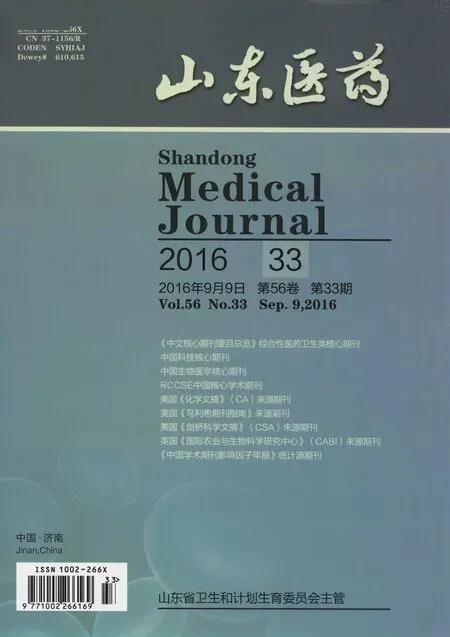siRNA抑制X连锁凋亡抑制蛋白基因对人HeLa细胞凋亡及周期的影响
唐薇薇,郑 洪,厉国慧,王琳琳
(1 遵义医学院,贵州遵义 563003;2 遵义医学院附属医院)
siRNA抑制X连锁凋亡抑制蛋白基因对人HeLa细胞凋亡及周期的影响
唐薇薇1,郑 洪2,厉国慧1,王琳琳1
(1 遵义医学院,贵州遵义 563003;2 遵义医学院附属医院)
目的探讨特异性siRNA对宫颈癌Hela细胞X连锁凋亡抑制蛋白(XIAP)基因的抑制作用及其抑制后细胞凋亡和细胞周期的变化。方法 设计合成XIAP特异性抑制siRNA,并将Hela细胞分成4组,即观察组(pGPU6/GFP/ Neo/ XIAP -siRNA转染细胞)、空白组(未加siRNA及转染试剂)、NC组(阴性对照,为所选目的序列被无序打乱的siRNA转染)、Mock 组 (转染试剂对照,加转染试剂未加siRNA)。RT-PCR法检测各组XIAP mRNA表达情况,流式细胞术检测各组细胞凋亡情况及细胞周期变化。结果 转染48、72 h,观察组XIAP mRNA表达分别为20.20±0.10、19.99±0.14,空白组分别为21.43±0.04、20.95±0.15,两组比较均有统计学差异(P均<0.05)。转染48 h,观察组、空白组细胞凋亡率分别为(28.91±0.12)%、(9.73±0.02)%;转染72h,观察组、空白组细胞凋亡率分别为(37.29±0.10)%、(10.62±0.04)%;观察组细胞凋亡率均高于空白组(P均<0.05)。空白组、Mock组、NC组间XIAP mRNA表达、细胞凋亡率比较均无统计学差异(P均>0.05)。与空白组相比, 观察组转染48、72 h后G0~G1期细胞增多而S期细胞减少(P均<0.05)。结论 特异性XIAP-siRNA可有效沉默宫颈癌Hela细胞XIAP基因,抑制细胞增殖并促进细胞凋亡。
宫颈肿瘤;Hela细胞;X连锁凋亡抑制蛋白;微小干扰iRNA
宫颈癌是女性常见的恶性肿瘤,其发病率和病死率呈逐年增高的趋势。目前对宫颈癌的治疗大多采用传统的手术、放疗或化疗等手段,常常在杀死肿瘤细胞的同时,对正常的组织细胞也产生了不同程度的损伤。因此,如果能针对肿瘤细胞的特异性靶点治疗,既能有效杀死肿瘤细胞,又能避免损伤正常细胞。X连锁凋亡抑制蛋白(XIAP)是凋亡抑制蛋白家族的重要成员,在宫颈癌细胞中高表达[1],其可直接结合和抑制caspases进行多途径调节细胞凋亡[2,3]。2006年6月,我们运用RNA干扰技术,将针对XIAP基因的特异性微小干扰RNA(siRNA)转染宫颈癌Hela细胞,观察其对细胞凋亡、基因表达及细胞周期的影响,以便为宫颈癌的特异性靶向治疗提供依据。
1 材料与方法
1.1细胞及试剂宫颈癌HeLa细胞株购自ATCC;pGPU6/GFP/Neo 购自上海吉凯化学公司;质粒小提中量试剂盒购自Tiangen公司;新生小牛血清(NBS)购自杭州四季青生物公司;RT-PCR反应试剂盒购自Tiangen公司;PCR引物由上海捷瑞生物公司合成;流式试剂盒购自Invitrogen公司;LipofectamineTM2000购自Nvitrogen公司。
1.2pGPU6/GFP/Neo/XIAP-siRNA 构建与鉴定根据shRNA 的设计原则,从GenBank 中XIAP mRNA (NM001167) 上找到符合特征的靶序列。互补的寡核苷酸链在退火缓冲液作用下,经处理得到shRNA模板链以用于连接反应。再取pGPU6/GFP/Neo质粒载体行酶切处理, 进行载体连接反应。在每个连接反应中随机挑选5个菌落,将其接种于含50μg/mL Kanamycin的LB培养基中。用碱裂解法抽提质粒,并用BamH I、Pst I分别进行酶切鉴定。
1.3细胞培养转染及分组将宫颈癌细胞HeLa株培养于含10%NBS的RPMI1640培养基,取对数生长期细胞接种于6孔板中,5×105/孔,至细胞密度达70%进行转染。操作步骤按LipofectamineTM2000说明书进行。将Hela细胞随机分成4组并进行相应处理,即观察组(pGPU6/GFP/ Neo/ XIAP -siRNA转染)、空白组(未加siRNA及转染试剂)、NC组(阴性对照,为所选目的序列被无序打乱的siRNA转染)、Mock 组 (转染试剂对照,加转染试剂未加siRNA)。
1.4 XIAP mRNA表达检测转染48、72 h,各组细胞提取总RNA,按Trizol Reagent 总RNA提取试剂盒方法操作,进行荧光定量PCR反应。每组均重复3次,取平均Ct值。以空白组作为对照,按2-ΔΔCt法分析转染后XIAP mRNA的表达情况。2-ΔΔCt值为转染后XIAP mRNA表达量较空白组XIAP mRNA表达量的倍数,XIAP mRNA干扰效率=(空白组2-ΔΔCt-观察组2-ΔΔCt)/空白组2-ΔΔCt×100%。
1.5细胞凋亡检测转染48、72 h,收集各组细胞,制备细胞悬液,预冷PBS洗涤2次;重悬于4×Binding Buffer, 使细胞密度为1×106/mL;采用流式细胞仪检测细胞凋亡情况。
1.6细胞周期变化情况检测转染48、72 h,细胞重悬于4 ℃含30 g/L 牛血清白蛋白的乙醇中, 4 ℃固定24 h,离心,弃上清。预冷 PBS洗细胞2次,离心,弃上清。加50 mg/L的RNase 1 mL,室温避光30 min,离心,弃上清。加入60 mg/L的PE 1 mL,室温避光30 min,流式细胞仪检测细胞周期中各期细胞构成情况。

2 结果
2.1pGPU6/GFP/Neo/XIAP-siRNA 重组质粒鉴定及细胞转染情况合成编码siRNA 模板链DNA,与线性化pGPU6/GFP/Neo 在T4 DNA 连接酶作用下连接,转化感受态细胞TOP10,筛选阳性质粒,提取DNA,显示酶切结果和测序结果与设计序列完全一致。空载体pGPU6/GFP共有5 117 bp,BamHⅠ位于1 663 bp,BbsⅠ位于1 720 bp,PstⅠ位于1 679 bp;阳性重组载体可以被BamHⅠ和BbsⅠ切开,而不能被PstⅠ切开。带有绿色荧光蛋白的pGPU6/GFP/Neo/XIAP-siRNA质粒转染细胞后,荧光显微镜观察到70%~80%的细胞显示绿色荧光。
2.2各组XIAP mRNA表达及XIAP mRNA干扰效率转染48、72 h,观察组与空白组XIAP mRNA表达比较有统计学差异(P均<0.05),空白组、Mock组和NC组比较无统计学差异(P均>0.05)。见表1。观察组转染48 h和72 h,HeLa细胞中XIAP mRNA的干扰效率分别为27%、59%。

表1 各组转染后XIAP mRNA表达比较
2.3各组细胞凋亡情况转染48 h,观察组、空白组、Mock组、NC组细胞凋亡率分别为(28.91±0.12)%、(9.73±0.02)%、(12.61±0.05)%、(10.90±0.08)%;转染72 h,观察组、空白组、Mock组、NC组细胞凋亡率分别为(37.29±0.10)%、(10.62±0.04)%、(12.93±0.07)%、(12.35±0.10)%。转染48 h和72 h,观察组细胞凋亡率均高于空白组(P均<0.05),空白组、NC组、Mock组细胞凋亡率比较无统计学差异(P均>0.05)。观察组转染48 h与转染72 h的细胞凋亡率比较有统计学差异(P<0.05)。
2.4观察组转染不同时间各期细胞构成变化转染48 h和72 h,观察组G0~G1期细胞分别为(59.02±0.13)% 和(62.25±0.12)%, S期细胞分别为(38.08±0.09)%和(33.48±0.06)%。与空白组相比, 观察组G0~G1期增加而S期减少(P均<0.05)。见图1。

图1 两组转染不同时间各期细胞构成情况
4 讨论
RNA干扰是进化过程中高度保守、由双链RNA(dsRNA)诱发、同源mRNA高效特异性降解的现象。将特异性siRNA递送进入生物细胞内均可引发RNA干扰,进而抑制特定基因的表达。大量研究表明,RNA干扰可用于治疗蛋白过度表达相关疾病和单基因疾病[4]。XIAP基因是凋亡抑制蛋白家族中作用最强的一个基因,其可通过如下机制抑制细胞调亡:①导致caspase功能受到直接抑制;②通过参与信号转导途径抑制细胞凋亡;③通过NF-κB途径抑制细胞调亡;④通过死亡受体通路介导引起细胞凋亡;⑤影响p53的功能[5]。
La Casse等[6]运用针对XIAP的反义寡核苷酸特异性下凋XIAP表达,可诱导肿瘤细胞凋亡。Wang等[7]研究表明,通过抑制XIAP可有效促进卵巢癌细胞凋亡。本研究以pGPU6/GFP/Neo荧光质粒为载体构建靶向XIAP siRNA真核表达质粒载体,针对肿瘤特定基因的位点引发干涉作用,从而更为有效地抑制目的基因的表达。本研究显示,将特异性荧光质粒pGPU6/GFP/Neo/XIAP-siRNA成功转染HeLa细胞后,可明显抑制XIAP mRNA表达;从干扰效率来看,靶向siRNA-XIAP对HeLa细胞的XIAP基因抑制效果具有特异性和高效性;导入重组质粒后,也诱导和促进了HeLa细胞凋亡,随转染时间的延长,其凋亡率呈增高趋势。同时,转染后细胞周期发生变化,进入G0~G1期细胞明显增多,S期细胞明显减少。这可能是因为转染后HeLa细胞增殖信号受到抑制,细胞周期进展受阻,细胞的增殖能力降低,导致细胞周期出现G0~G1期阻滞和细胞增殖抑制、S期表达下降,从而促进细胞凋亡进程。以上结果证实,XIAP表达下调可抑制宫颈癌HeLa细胞增值并促进其凋亡。
肿瘤的发生是细胞增殖与凋亡失衡的结果,特异性靶向治疗是提高治疗效果的一个重要途径。随着siRNA技术的不断发展,多靶点联合治疗在促进肿瘤细胞凋亡以及提高肿瘤细胞对化疗药物的敏感性中都发挥了重要作用,具有广阔的应用前景[8~10]。
[1] Yano K, Horinaka M, Yoshida T, et al. Chetomin induces degradation of XIAP and enhances TRAIL sensitivity in urogenital cancer cells [J]. Int J Oncol, 2011,38(2):365-374.
[2] Park CM, Sun CH, Olejniczak ET, et al. Non-peptidic small molecule inhibitors of XIAP [J] .Bioorg Med Chem Lett, 2005,15(3) :771-775.
[3] Zhang Y, Zhu J, Tang Y, et al. X-linked inhibitor of apoptosis positive nuclear labeling:a new independent prognostic biomarker of breast invasive ductal carcinoma [J]. Diagn Pathol, 2011, 7(6):49.
[4] Wittrup A, Lieberman J. Knocking down disease: a progress report on siRNA therapeutics [J].Nat Rev Genet, 2015,16(9):543-552.
[5] 张亚雷,张世能.凋亡抑制蛋白XIAP与消化系肿瘤关系的研究进展[J].国际内科学杂志,2007,34(11):657-659.
[6] La Casse EC,Cherton-Horvat GG, Hewitt KE, et al. Preclinical Characterization of AEG35156/ GEM 640,a second-generation antisense oligonucleotide targeting X-linked inhibitor of apoptosis [J]. Clin Cancer Res, 2006,12(17):5231-5241.
[7] Wang JH, Nao JF, Zhang M,et al.20(s)-ginsenoside Rg3 promotes apoptosis in human ovarian cancer HO-8910 cells through PI3K/Akt and XIAP pathwas [J]. Tumour Biol, 2014,35(12):11985-11994.
[8] Mehrotra S, Languino LR, Raskett CM, et al. IAP regulation of metastasis[J]. Cancer Cell, 2010,17 (1):53-64.
[9] Pang Y, Mao H, Shen L, et al. Mir-519d reperesses ovrian cancer cell proliferation and enhances cisplatin-mediated cytotoxicity in vitro by targeting XIAP [J]. Onco Targets Ther, 2014,23(7):587-597.
[10] Pietenpol JA, Stewart ZA. Cell cycle checkpoint signaling: Cell cycle arrest versus apoptosis [J]. Toxicology, 2002(181-182):475- 481.
XIAP gene inhibited by siRNA and its effect on apoptosis and cell cycle of HeLa cells
TANGWeiwei1,ZHENGHong,LIGuohui,WANGlinlin
(1ZunyiMedicalCollege,Zunyi563003,China)
ObjectiveTo explore the inhibitory effect of small interfering RNA(siRNA) silencing human X-linked inhibitor of apoptosis protein (XIAP) gene on cell cycle and apoptosis of cervical HeLa cells.MethodsDNA template coding XIAP specific siRNA was designed and synthesized. The Hela cells were divided into 4 groups: the observation group (pGPU6/GFP/Neo/XIAP-siRNA-transfected cells), blank group (not added with siRNA and transfection reagent), negative control group (NC group, transfected by disrupted siRNA) and transfection reagent control group (Mock group, added with transfection reagents and without siRNA). The XIAP-siRNA was transfected into HeLa cells. The expression level of XIAP mRNA was assayed by RT-PCR. The apoptosis rate and cell cycle distribution were analyzed by flow cytometry.ResultsSignificant difference was found in the expression of XIAP mRNA at 48 and 72 h after transfection between the observation group and blank group (allP<0.05), but no significant difference was found among the blank group, Mock group and NC group (allP>0.05). In the observation group, the interference rates of HeLa cells transfected with XIAP-siRNA at 48 and 72 h were 27% and 59%. The apoptotic rate of the observation group was higher than that of the blank group (allP<0.05). Significant difference was found in the apoptosis rate of the observation group between the transfection of 48 h and 72 h (P<0.05). Compared with the blank group, the cells in the G0-G1phrase increased and then decreased in the S phrase at 48 and 72 h after transfection (allP<0.05).CondnsionSpecific XIAP-siRNA can effectively silence the XIAP gene of cervical cancer Hela cells, inhibit the proliferation and promote the apoptosis.
cervical neoplasms; Hela cells; X-linked inhibitor of apoptosis protein; small interfering RNA
贵州省科技厅基金资助项目(黔科合J字[2007]2128号)。
唐薇薇(1980-),女,讲师,医学硕士,研究方向为肿瘤分子病理学。E-mail:wo19701110@163.com
简介:郑洪(1962-),男,教授,博士,研究方向为肿瘤分子病理学。获贵州省科技进步三等奖2项、遵义市科学技术进步二、三等奖各1项。E-mail:zhenghonghq@hotmail.com
10.3969/j.issn.1002-266X.2016.33.007
R737.3
A
1002-266X(2016)33-0022-03
2016-05-09)

